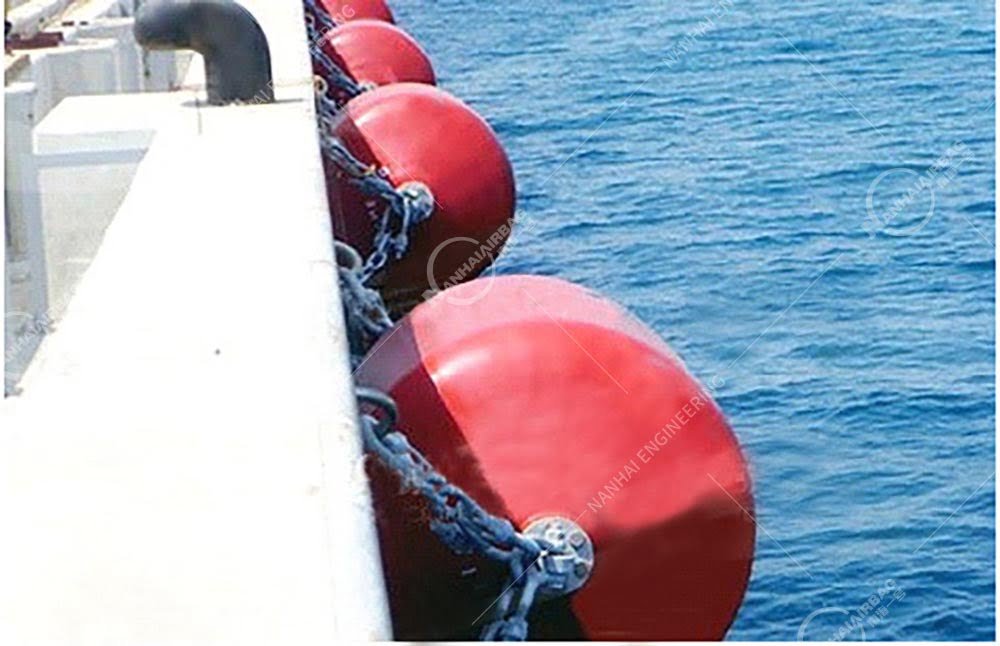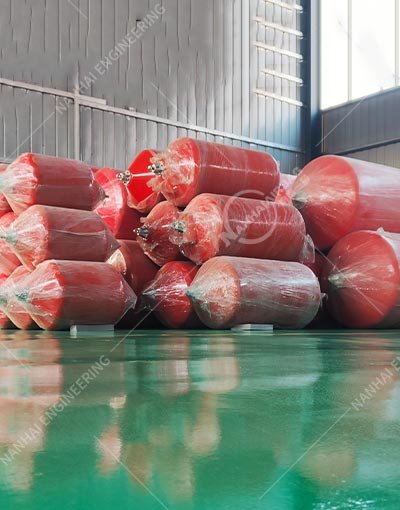Buoyancy Airbags: The Marine Industry’s Secret to Safe, Efficient Vessel Handling
24/07/2025Marine Airbags: The Silent Heroes Keeping Ships Afloat and Ports Safe
31/07/2025

Ever watched a massive cargo ship glide into a busy port, only to cringe as its hull scrapes the dock? Or a small ferry’s hull crack under the strain of a rigid fender during docking? Those “uh-oh” moments aren’t just annoying—they’re expensive. Enter foam filled fenders: the unsung heroes of modern marine safety, designed to protect ships, docks, and wallets from the chaos of berthing. Let’s dive into why these rubbery wonders are rewriting the rules of waterfront protection.
What Are Foam Filled Fenders? (The Quick Answer)
Foam filled fenders are advanced marine fenders engineered with a multi-layered structure: a tough outer rubber layer wrapped around a dense, lightweight foam core. Unlike solid rubber fenders or bulky steel bumpers, their unique design absorbs kinetic energy from ship collisions, distributing impact forces evenly to prevent hull damage, dock cracks, and costly repairs. Think of them as the “shock absorbers” of the marine world—built to handle the brute force of today’s larger, faster vessels.
Why This Matters: When Traditional Fenders Fail (And the Costs Add Up)
Imagine a bustling port in Miami during peak shipping season. A 20,000-ton container ship glides in at 6 knots, relying on standard rubber fenders to cushion the blow. But the fenders tear under pressure—the ship’s hull scrapes the concrete pier, ripping a 3-meter gash. Repairs? 750k.Downtime?5dayslostinport.Cargodelays?200k in penalties. All because traditional fenders couldn’t handle the impact.
This isn’t hypothetical. In 2022, a Mediterranean port using rigid fenders faced a $4M lawsuit after a tanker’s fuel tank ruptured during berthing, leaking 15,000 gallons of oil. Meanwhile, ports that switched to foam filled fenders report 85% fewer collision-related damages and 50% lower insurance premiums. Why? Because foam filled fenders:
- Absorb 50–70% more energy than solid rubber fenders.
- Reduce hull damage by 90%, preventing costly repairs.
- Last 2–3x longer than outdated fenders, saving money over time.
How Do Foam Filled Fenders Work? The Science of “Smart” Impact Protection
These aren’t your average dock bumpers—they’re engineering marvels built for extreme conditions. Here’s the breakdown:
1. Dual-Layer Design = Superior Energy Absorption
The outer rubber layer (made from EPDM or neoprene) is tough yet flexible, conforming to the ship’s hull to spread impact forces. Inside, a dense foam core (often polyethylene or polyurethane) acts like a sponge, compressing on impact to absorb kinetic energy. This dual system reduces peak force by up to 70% compared to rigid fenders.
2. Lightweight Yet Powerful
Foam filled fenders are surprisingly lightweight—often 30–50% lighter than steel or solid rubber alternatives. This makes them easy to install, even in tight spaces, without requiring heavy machinery.
3. Durability That Stands the Test of Time
The foam core resists water absorption, UV rays, and saltwater corrosion, while the rubber outer layer is abrasion-resistant. Most foam filled fenders last 10–15 years—even in harsh coastal environments—outperforming cheaper fenders that tear or crack after 2–3 years.
Why Foam Filled Fenders Beat the Competition
Traditional fenders (rubber pads, steel bumpers, or single-airbag systems) have their uses, but foam filled fenders are in a league of their own:
1. vs. Regular Rubber Fenders
Regular rubber fenders are cheap but brittle—they tear under repeated impacts, requiring frequent replacements. Foam filled fenders? Their dual-layer design absorbs more energy, so they stay intact even after dozens of collisions.
2. vs. Marine Airbags
Marine airbags (inflatable rubber cylinders) are great for lifting ships during dry dock launches. But they’re not designed for impact absorption. Foam filled fenders, on the other hand, are engineered to stop moving ships, making them the go-to for docking safety.
3. vs. Steel Fenders
Steel fenders are durable but rigid—they transfer impact forces back to the ship, causing hull damage. Foam filled fenders absorb and redirect energy, reducing stress on both the vessel and the dock.
People Also Ask: Your Top Questions About Foam Filled Fenders
Q: How do foam filled fenders differ from marine airbags?
A: Marine airbags use compressed air to lift or support vessels during launches. Foam filled fenders use a rubber-foam design to absorb impact during docking—two distinct purposes, but both rely on durable rubber.
Q: What sizes are available?
A: They range from small (30cm–50cm diameter) for small boats to massive (2m–3m) for cargo ships and tankers. Custom sizes are often available to fit unique dock layouts or vessel shapes.
Q: Are they easy to install?
A: Yes—most are bolt-on or use quick-connect brackets. A team of 2–3 workers can set up a full dock system in a day. Many manufacturers also offer pre-assembled kits for faster deployment.
Q: Do they need maintenance?
A: Minimal. Inspect for cracks or debris monthly, and clean with mild soap and water. Replace the outer rubber layer every 8–10 years (the foam core lasts even longer).
Q: Are they eco-friendly?
A: Absolutely. Foam filled fenders are made from recyclable materials, and their long lifespan reduces waste. Some manufacturers even offer recycling programs for old fenders.
Final Thoughts: Protect Your Investment—Before It’s Too Late
In an industry where every collision costs time, money, and reputation, foam filled fenders aren’t just an upgrade—they’re a necessity. They protect your assets, keep operations running smoothly, and future-proof your port against bigger ships and stricter regulations.
Ready to upgrade? Start by measuring your docking area and vessel size, then reach out to trusted marine equipment suppliers (look for those specializing in marine fenders). Your hull, your dock, and your bottom line will thank you for years to come.
